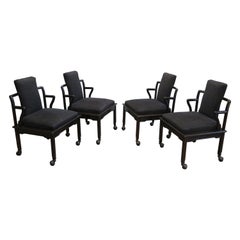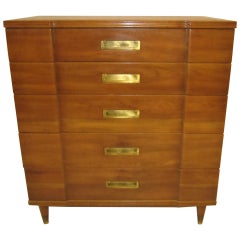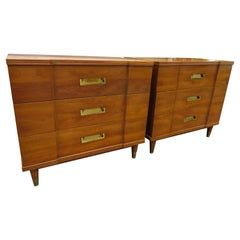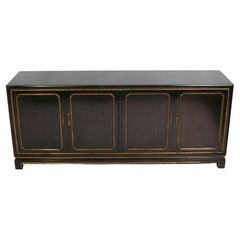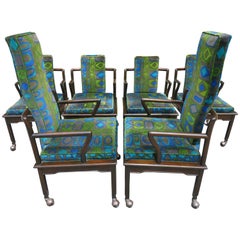John Widdicomb Asian
John Widdicomb Asian Inspired Chairs
By John Widdicomb
Located in New York, NY
John Widdicomb Asian inspired chairs. Vintage Mid-Century Modern chairs by John Widdicomb. Chinese
Category
Vintage 1960s Mid-Century Modern Dining Room Chairs
Materials
Walnut
Gorgeous John Widdicomb Asian Influenced Tall Dresser Mid-century Modern
By John Widdicomb
Located in Pemberton, NJ
This 5 drawer dresser is a fine example of the level of craftsmanship and the standards of the John
Category
Vintage 1950s American Mid-Century Modern Dressers
Materials
Brass
$2,240 Sale Price
20% Off
H 44.25 in W 40.5 in D 21 in
Handsome Pair Asian Style John Widdicomb Night Stands Mid-Century Modern
By John Widdicomb
Located in Pemberton, NJ
Handsome pair of John Widdicomb Asian-style nightstands/end tables. We love that the backs are also
Category
Vintage 1960s American Mid-Century Modern Night Stands
Materials
Brass
$3,080 Sale Price / set
20% Off
H 25 in W 25 in D 18 in
Asian Modern John Widdicomb Square Lacquered Table with Incised Decoration
By John Widdicomb
Located in Houston, TX
Asian Modern John Widdicomb square lacquered table with incised decoration. This gorgeous low table
Category
Vintage 1960s North American Chinese Export Side Tables
Materials
Wood, Lacquer
$2,200
H 15 in W 18 in D 18 in
Handsome Pair Asian Style John Widdicomb Bachelors Chests Mid-Century Modern
By John Widdicomb
Located in Pemberton, NJ
Handsome pair of John Widdicomb Asain style bachelors chests. These are fine examples of the level
Category
Vintage 1950s American Mid-Century Modern Commodes and Chests of Drawers
Materials
Brass
$4,800 Sale Price / set
20% Off
H 32.5 in W 36.25 in D 21 in
Asian Influenced Mid Century Credenza by John Widdicomb Espresso Brown Gold Trim
By John Widdicomb
Located in Atlanta, GA
Asian Influenced Mid Century Credenza, designed for the John Widdicomb Company, American, circa
Category
Vintage 1960s American Mid-Century Modern Credenzas
Materials
Metal, Brass
$5,800
H 32 in W 76.5 in D 19 in
Magnificent Hermes Orange Widdicomb Credenza Asian Brass Mid-Century Modern
By John Widdicomb
Located in Pemberton, NJ
Magnificent Hermes orange lacquered John Widdicomb credenza buffet. We love the Asian Campaign
Category
Vintage 1960s American Mid-Century Modern Credenzas
Materials
Brass
$5,480 Sale Price
20% Off
H 32.25 in W 578.25 in D 21 in
Fabulous Asian Modern Widdicomb Dining Chairs Jack Lenor Larsen Blue Velvet
By John Widdicomb, Jack Lenor Larsen
Located in Pemberton, NJ
Fabulous Asian modern set of six dining chairs by Widdicomb, two armchairs and four side chairs. We
Category
Vintage 1960s American Mid-Century Modern Dining Room Chairs
Materials
Upholstery, Mahogany
$4,500 / set
H 45 in W 21 in D 21.5 in
Recent Sales
Gorgeous John Widdicomb Asian Influenced Credenza Mid-century Modern
By John Widdicomb
Located in Pemberton, NJ
the John Widdicomb Furniture Company. This piece is made of solid wood, using dovetail, and dado
Category
Vintage 1950s American Mid-Century Modern Credenzas
Materials
Brass
John Widdicomb Asian Modern Dining Set Table Chairs Buffet China
By John Widdicomb
Located in Wayne, NJ
John Widdicomb Diningroom set. Includes 2 Captain Armchairs, 8 Side chairs. 6' Table with an
Category
Vintage 1970s American Mid-Century Modern Dining Room Sets
Materials
Wood
John Widdicomb Asian Modern Dining Set Table Chairs Buffet China
By John Widdicomb
Located in Wayne, NJ
John Widdicomb Diningroom set. Includes 2 Captain Armchairs, 8 Side chairs. 6' Table with an
Category
Vintage 1970s American Dining Room Chairs
Materials
Wood
Fantastic Pair of John Widdicomb Asian Modern Night Stands Mid-Century
By John Widdicomb
Located in Pemberton, NJ
Lovely pair of asian modern night stands/end tables made by John Widdicomb. This pair retains
Category
Vintage 1950s American Mid-Century Modern Night Stands
Materials
Brass
John Widdicomb Asian Modern Cabinet or Sideboard, Buffet Gold Relief
By Widdicomb Furniture Co.
Located in Houston, TX
Asian Modern sideboard or cabinet made by John Widdicomb with gold relief art. The sideboard is
Category
Vintage 1960s American Hollywood Regency Buffets
Materials
Brass
Mid-Century Asian Inspired Cocktail Table
By John Widdicomb
Located in Wilton, CT
Truly outstanding 1960's John Widdicomb Asian inspired cocktail table. Very much in the style of
Category
Vintage 1960s American Mid-Century Modern Coffee and Cocktail Tables
Materials
Grasscloth, Lacquer, Glass
John Widdicomb Oxford Finish Mahogany Block Front Bachelor Chests, a Pair
By John Widdicomb
Located in Germantown, MD
A pair of John Widdicomb Oxford Finish Mahogany Block Front 4 Drawer Bachelor chests. In Very Good
Category
Mid-20th Century American Chippendale Furniture
Materials
Brass
H 34 in W 36.25 in D 20.25 in
Widdicomb Asian Inspired Midcentury Mahogany Extended Dining Table
By John Widdicomb
Located in Rio Vista, CA
. Rare table produced by John Widdicomb with its Asian inspired design attributed to T.H Robsjohn
Category
20th Century American Mid-Century Modern Dining Room Tables
Materials
Metal
Pair of John Widdicomb Coromandel Lacquer Carved Chinoiserie End Side Tables
By John Widdicomb
Located in Swedesboro, NJ
. There will be times when additional patience will be necessary.
This is a fine Pair of John Widdicomb
Category
Mid-20th Century American End Tables
Materials
Wood
H 15.5 in W 18 in D 18 in
Pair of Mario Buatta for Widdicomb Asian Chinoiserie Ebonized Nesting Tables
By Widdicomb Furniture Co., Mario Buatta, John Widdicomb
Located in Hudson, NY
Decorative pair of very usable solid nesting tables with a subtle decorative chinoiserie style. These tables also function well independently. Constructed of ebonized mahogany. Finis...
Category
Mid-20th Century American Chinoiserie Nesting Tables and Stacking Tables
Materials
Mahogany
H 24.25 in W 27.75 in D 27.75 in
Gorgeous John Widdicomb Asian Influenced Tall Dresser, Mid-Century Modern
By John Widdicomb
Located in Pemberton, NJ
This 5 drawer dresser is a fine example of the level of craftsmanship and the standards of the John
Category
Vintage 1950s American Mid-Century Modern Dressers
Materials
Brass
H 44.25 in W 40.5 in D 21 in
Asian Mid Century Coffee Table by John Widdicomb, c1970s
By John Widdicomb
Located in Chino Hills, CA
table by John Widdicomb, circa 1970s. A prized piece for collectors and connoisseurs of fine furniture
Category
Vintage 1970s American Mid-Century Modern Coffee and Cocktail Tables
Materials
Wood
Pair of Red Orange Asian Chinoiserie Side Tables/Stools
By John Widdicomb, Baker Furniture Company
Located in Houston, TX
Gorgeous pair of red orange lacquered side tables with beautiful hand-painted mountain landscapes in gold. Vintage condition. Old touch ups.
Dimension for the tabletop: 13 in. dia...
Category
Mid-20th Century Asian Chinoiserie End Tables
Large Mid Century Modern Asian Inspired Corner Two Tier Step Table
By John Widdicomb, T.H. Robsjohn-Gibbings
Located in Rockaway, NJ
Very nice Mid-Century Modern corner side step table.
Category
20th Century American Mid-Century Modern Side Tables
Materials
Walnut
Bert England Orientation Group Carved Ebonized Mahogany Tall King Headboard
By John Widdicomb, Bert England
Located in Southampton, NJ
A rarely offered king headboard designed by Bert England for John Widdicomb Furniture.
Slight Asian
Category
Vintage 1950s American Hollywood Regency Beds and Bed Frames
Materials
Mahogany
H 81.5 in W 80 in D 1.75 in
Bert England Orientation Group Carved Mahogany Tall King Headboard
By Bert England, John Widdicomb
Located in Chicago, IL
A rarely seen offered king headboard designed by Bert England for John Widdicomb furniture. Slight
Category
Vintage 1960s American Beds and Bed Frames
Materials
Mahogany
Widdicomb Set of Six Asian Modern Black Lacquer Dining Chairs, circa 1960
By John Widdicomb
Located in Austin, TX
Set of six dining chairs by John Widdicomb in Mid-Century Modern Chinese inspired style. Black
Category
Mid-20th Century American Mid-Century Modern Dining Room Chairs
Materials
Silk, Wood
Pair of Bombe Nightstands by John Widdicomb
Located in Treasure Island, CA
John Widdicomb design. Asian styling. Signed. A fine and rare pair.
Category
20th Century American Night Stands
Materials
Brass
Midcentury Wall Mirror by Widdicomb
By John Widdicomb
Located in West Palm Beach, FL
Glamorous midcentury wall mirror by John Widdicomb, circa 1960s. This stunning Asian inspired
Category
Vintage 1960s American Mid-Century Modern Wall Mirrors
Materials
Mirror, Walnut, Wood
People Also Browsed
'Plissé White Edition' Pleated Textile Table Lamp by Folkform for Örsjö
By Örsjö Industri AB
Located in Glendale, CA
'Plissé White Edition' pleated textile table lamp by Folkform for Örsjö.
This unique table lamp was awarded “Lighting of the Year 2022” by Residence Magazine Sweden, who called it “...
Category
21st Century and Contemporary Swedish Mid-Century Modern Table Lamps
Materials
Textile
$1,650 / item
H 16.1 in Dm 11.5 in
Organic Modern Small Table Lamp Natural Wood Handmade Ivory Fluted Shade
By Isabel Moncada
Located in San Antonio, TX
PATA DE ELEFANTE SMALL table lamp was designed for the Atomic collection by Mexican artist Isabel Moncada.
Named Pata de Elefante –Elephant's Foot– for the prominent shape at its ba...
Category
21st Century and Contemporary Mexican Mid-Century Modern Table Lamps
Materials
Wood, Fabric, Linen, Fiberglass
$2,500 / item
H 29 in Dm 19 in
Pair of Modern Walnut Side Tables
Located in Westwood, NJ
A Pacific walnut side table, the square top with rounded corners and a reeded edge above a similar under tier, on bobbin turned legs.
Dimensions: 26" W x 26" D x 28.5" H.
Category
21st Century and Contemporary Vietnamese Modern End Tables
Materials
Wood
Walnut Campaign Dresser in the Style of Henredon
By Dixie, Henredon
Located in Redding, CT
Walnut campaign dresser in the style of Henredon. Classic 5 drawer dresser with chunky recessed brass plated hardware and recessed plinth base. This Iconic "Campaigner" dresser by Di...
Category
Vintage 1970s Mid-Century Modern Dressers
Materials
Metal, Brass
John Widdicomb Chest of Drawers
By John Widdicomb
Located in Brooklyn, NY
Pair of midcentury chests by John Widdicomb Company. Polished brass hardware compliments the fruitwood drawers.
Please confirm location NY or NJ.
Category
Mid-20th Century Mid-Century Modern Dressers
Materials
Brass
John Widdicomb Mid-Century Modern Mahogany Dresser or Credenza, Newly Refinished
By John Widdicomb
Located in South Bend, IN
An exceptional mid-century modern ten-drawer dresser or credenza
By John Widdicomb
USA, 1960s
Mahogany, with original hardware and unique flared lags.
Measures: 74" W x 2...
Category
Vintage 1960s American Mid-Century Modern Dressers
Materials
Mahogany
$4,495
H 31.13 in W 74 in D 20 in
Baker Milling Road Banded Front Campaign Style Tall Chest of Drawers - Dresser
By Baker Furniture Company
Located in Philadelphia, PA
Vintage Mid Century Modern Milling Road Tall Dresser by Baker. The dresser features a very nice Hollywood Regency / campaign style design with striking, figured wood grain, 5 dovetai...
Category
20th Century American Campaign Dressers
Materials
Brass
$5,800
H 45.5 in W 38 in D 20 in
John Widdicomb Hollywood Regency Campaign Black Lacquered Highboy Dresser, 1950s
By John Widdicomb
Located in South Bend, IN
An exceptional mid-century modern Hollywood Regency Campaign five-drawer highboy dresser
By John Widdicomb
USA, 1950s
Black lacquered solid cherry wood, with original brass hardwa...
Category
Vintage 1950s American Mid-Century Modern Dressers
Materials
Brass
$3,295
H 44.25 in W 40.25 in D 21 in
Pair of Night Stands Made of Rosewood, circa 1960, Mid-Century Modern
Located in North Miami, FL
Presenting a striking pair of rosewood nightstands, hailing from the chic era of the 1960s. These elegant pieces are adorned with brass handles, showcasing a timeless fusion of form ...
Category
Antique Mid-19th Century Mid-Century Modern Night Stands
Materials
Brass
$4,530 Sale Price / set
40% Off
H 14 in W 23 in D 19 in
John Widdicomb Nine Drawer Rosewood Dresser J. Stuart Clingman, 1950s
By John Widdicomb
Located in Camden, ME
Nine drawer dresser designed by J. Stuart Clingman for John Widdicomb Co. prior to his death in 1956.
Quarter-cut rosewood framing, sculpted facia, over hanging top drawers, book mat...
Category
Mid-20th Century American Mid-Century Modern Dressers
Materials
Brass
$4,000
H 32.5 in W 70 in D 21 in
SOLD 07/15/25 John Widdicomb Mid Century Walnut and Brass Highboy Dresser
By John Widdicomb
Located in Countryside, IL
John Widdicomb Mid Century Walnut and Brass Highboy Dresser
This highboy measures: 40.5 wide x 20 deep x 47 inches high
All pieces of furniture can be had in what we call restored ...
Category
Vintage 1970s American Mid-Century Modern Dressers
Materials
Brass
$3,895
H 47 in W 40.5 in D 20 in
Cavalier Mid Century Walnut and Brass 6 Drawer Highboy Dresser
Located in Countryside, IL
Cavalier mid century walnut and brass 6 drawer highboy dresser
The dresser measures: 38 wide x 20 deep x 45 inches high
All pieces of furniture can be had in what we call resto...
Category
Vintage 1960s American Mid-Century Modern Dressers
Materials
Brass
Get Updated with New Arrivals
Save "John Widdicomb Asian", and we’ll notify you when there are new listings in this category.
John Widdicomb Asian For Sale on 1stDibs
Find many varieties of an authentic john widdicomb Asian available at 1stDibs. Frequently made of wood, brass and metal, every john widdicomb Asian was constructed with great care. Whether you’re looking for an older or newer john widdicomb Asian, there are earlier versions available from the 20th Century and newer variations made as recently as the 20th Century. Each john widdicomb Asian bearing Mid-Century Modern or Hollywood Regency hallmarks is very popular. Many designers have produced at least one well-made john widdicomb Asian over the years, but those crafted by John Widdicomb, Widdicomb Furniture Co. and Jack Lenor Larsen are often thought to be among the most beautiful.
How Much is a John Widdicomb Asian?
The average selling price for a john widdicomb Asian at 1stDibs is $2,800, while they’re typically $1,550 on the low end and $17,000 for the highest priced.
More Ways To Browse
John Widdicomb Campaign
John Widdicomb Furniture Hand Painted
Chippendale 4 Drawer Chest
John Widdicomb Headboards
Faux Tortoise Shell Bar
Lane Black Lacquer
Lane Lacquered Brass
John Widdicomb Asian Furniture
Small Asian Chinoiserie Painted Cabinet
Butcher Block Cabinet
Widdicomb Chinoiserie
John Widdicomb King Bed
John Widdicomb Tall Dresser
Regency Chinoiserie Bookcase Cabinet
Lane Faux Bamboo
John Widdicomb Bombe
Wicker King Bed
Mario Buatta For Widdicomb
